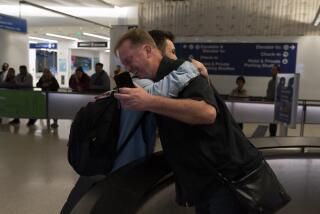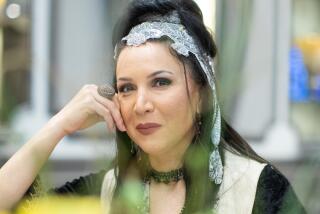The chalice that helped make possible the Iran nuclear deal
WASHINGTON â Many paths led to the international agreement to temporarily curb Iranâs nuclear program: secret meetings in Oman, formal negotiations in Geneva, and a quiet encounter in New York involving two diplomats and an exquisite silver chalice in the shape of a mythical winged creature.
The latter session led in September to the return of the chalice to Iran, where officials hailed it as a gesture of friendship by the United States. The move was orchestrated by a mid-level diplomat at the U.S. Mission to the United Nations who devised a way to work around a 30-year absence in formal relations.
âI wasnât sure we could pull it off,â he said. âThey donât talk to us. We donât talk to them.â
The diplomat has operated under rules that barred most contact with Iranian officials for his entire career. Even now, because of the sensitivity of relations between the two countries, he was allowed to discuss the exchange only on condition that he and others involved not be identified.
The episode began during the summer, when the Obama administrationâs Middle East experts met to debate a delicate matter of diplomacy: how to acknowledge the election of Iranâs moderate new president, Hassan Rouhani, in a way that might convey goodwill and show respect to the Iranian people.
One expert suggested that President Obama shake Rouhaniâs hand at the fall summit of the United Nations. Another posed the idea of a video message from Obama to Iranians.
But an Iran specialist came up with another possibility; returning the silver ceremonial chalice. Officials believe it was looted from an Iranian cave and imported illegally. It was seized by U.S. customs in 2003 and stored ever since in a shroud of cotton in a federal warehouse in Queens.
For a decade, Iran had sought return of the chalice, which officials there regarded as part of the countryâs cultural heritage. Meeting that demand, the Americans thought, could build goodwill for the U.S. and thereby strengthen Rouhani, who had won the presidency in part by promising to improve relations.
Bolstering Rouhani, they thought, would be key to reaching any deal on the nuclear program, which hard-liners in both Iran and the United States were sure to oppose.
âThis wouldnât just be a gesture for government officials,â said a senior administration official who took part in the meeting. âThis would be a gesture with meaning for the people of Iran.â
Some experts believe the vessel, known as a rhyton, was crafted in the 7th century BC in what later became the Persian Empire, now Iran. It features three trumpet-shaped cups that sprout from the body of a griffin, a fabled creature that typically has the head and wings of a bird and the body of a lion. On the chalice, the eyes are deep-set and wide open, like those of a bird of prey.
The object was allegedly part of a cache of antiquities found in a cave near the Iraqi border in the 1980s, shortly after Iranâs Islamic Revolution.
âThese were great treasures from a great civilization,â said Fariborz Ghadar, an Iranian scholar who served as a deputy economic minister to Iranâs shah. âTheir discovery was of great significance to those who consider themselves Persians, who honor that period in history.â
In 2003, the chalice surfaced in the hands of a well-known antiquities dealer, Hicham Aboutaam, who ran a firm based in Geneva. As he passed through U.S. customs at Newark International Airport, Aboutaam presented a certificate indicating the vessel was from Syria. He was waved through.
Aboutaam then set out to document the objectâs value. Three experts he consulted determined it was from Iran; two concluded it was consistent with the antiquities taken from the cave. An art collector was prepared to pay $1 million, but federal investigators caught wind of it. They charged that the object had been taken from Iran illicitly, making its importation to the U.S. illegal. The dealer was prosecuted and paid a $5,000 fine.
The chalice was then placed in a climate-controlled storage unit.
The value of the chalice remains uncertain. Some have maintained that it is not 2,700 years old at all, but a modern fake. But Iranian officials have insisted it is genuine and demanded its return.
In Iran, Ghadar said, seizure of any of the nationâs antiquities by the West âwas a sign of great disrespect.â
When Rouhani announced plans to attend the U.N. General Assembly in New York in September, Obamaâs advisors decided the moment was right for a gesture.
A day after Obama delivered his annual address to the world body, the American diplomat received an email from Washington, which he read at his desk three blocks from U.N. headquarters. He was instructed to find a way to return the griffin chalice to the Iranians with no fanfare before Rouhani left in two days.
A courier from the Department of Homeland Security, of which customs is a division, took the griffin in a dusty brown box from Queens to the Manhattan offices of the U.S. Mission to the U.N.
The diplomat signed for it in the lobby, then set in motion a plan he had been devising.
U.S. and Iranian diplomats can talk with one another on a short list of issues, such as helping the Iranians set up a bank account or get diplomatic license plates.
The U.S. diplomat called the Iranian contact for such matters and said he had something to deliver before Rouhani left. The Iranian agreed to meet.
Quickly, the diplomat took a photo of the griffin and printed a card explaining its history and why it was in U.S. hands. The Iranian contact might not recognize the object, he worried.
Thinking a cardboard box was no way to present a precious object, he bought a white gift bag at Hallmark, choosing that color so as not to imply it was a gift.
âPlain white gift bags are actually kind of hard to find,â he said in a recent interview.
Clutching the bag as he walked to the meeting, he was relieved that the place he had chosen was outside the security perimeter in a section of U.N. headquarters that was mostly vacant due to renovations.
âI didnât know how I was going to explain this if it went through security screening,â he said.
When he took his seat, he slid the bag across the conference table. He said the United States wanted to give the griffin to Rouhani. The Iranian diplomat looked inside. His eyes grew wide.
The Iranian stood, looked at the American and thanked him. In the U.S. diplomatâs 10 years in the foreign service, he had never had a one-on-one meeting, let alone extended eye contact, with an Iranian peer.
âHe gave this lovely speech, telling me how much this meant to the Iranian people, and to him personally,â the U.S. diplomat said. âIt was an important moment. I know Iâll never forget it.â
Two days later, Rouhani accepted a telephone call from Obama, the first such high-level contact since 1979, when militants stormed the U.S. Embassy in Tehran, taking hostages they held for 444 days.
In the United States, the diplomatic handoff, which the State Department revealed in a Twitter message, drew mixed reactions.
âThere is a thin line between gestures of friendship and gestures that display desperation to negotiate,â said Elliott Abrams, a foreign policy advisor to Presidents Reagan and George W. Bush. âI think a gesture like moving carriers into the [Persian] Gulf is more likely to get us a successful negotiation.â
But Ghadar said the griffinâs return sent an important message to Iranians.
âThe Iranians kept saying, âWe want you to show us respect,ââ he said. âThis says, âWith respect to the Iranian people, we are sending this back.ââ
In Tehran, Rouhani spoke to the news media after returning from the U.N. Reclining in an armchair in a wood-paneled conference room, he said the return of the griffin took place with âdue ceremony.â
A day later, Mohammad Ali Najafi, the head of Iranian cultural heritage and tourism, summoned reporters to his office. Beaming, he gently held the griffin aloft and called it âa sign of goodwill from the U.S.A.â
Photos appeared in pro-reform newspapers, while hard-liners, angered by Rouhaniâs overtures to the West, dismissed the chalice as fraudulent.
âWe do not look a gift horse in the mouth,â Najafi said. âEven if it is fake, it is worthy.â
Special correspondent Ramin Mostaghim in Tehran contributed to this report.
More to Read
Sign up for Essential California
The most important California stories and recommendations in your inbox every morning.
You may occasionally receive promotional content from the Los Angeles Times.











